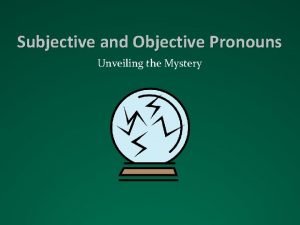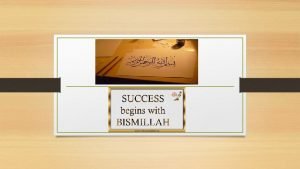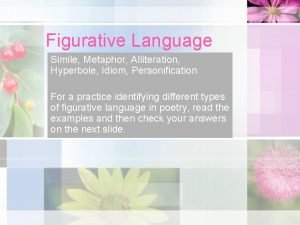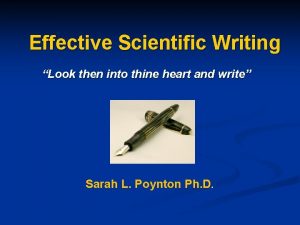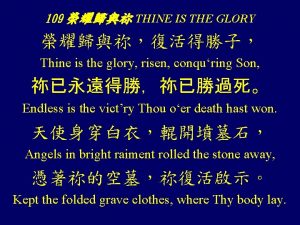Effective Scientific Writing Look then into thine heart




















- Slides: 20

Effective Scientific Writing “Look then into thine heart and write” Sarah L. Poynton Ph. D.

Introduction and Discussion

Introduction and Discussion reflections of each other

Introduction

Introduction

Introduction What did you study, and why did you study it? General subject What are the limits of knowledge? Specific problem you studied, why it is of interest Findings of others to be challenged or developed

What was your hypothesis? Experimental approach and rationale Goals of your study Principal findings and conclusions (optional)

Hints and tips – how to write an effective introduction Move from general to specific, from strategy to details Write from the readers perspective – be logical! Keep to the point – avoid side issues Cite review articles – but do not write one In early drafts, identify the references by author names and year

Exercise time! Write a bulleted outline

Questions and comments?

Discussion

A discussion can be unruly and disorganized…….

Or well thought out, and carefully reasoned !

What is the framework for an effective discussion?

What points do you want to make?

What is the reflection of the information and goals set out in the introduction ? What contribution to knowledge and understanding have you made?

Discussion What does your work mean? Answer the research question(s) asked in your introduction - outline the principles and relationships indicated by your data, - highlight key results – what has been observed for the first time Compare (similarities) and contrast (differences) with previous work Point out an unexpected or inconsistent results, limitations of data, unsettled details Recommendations

Exercise time! Write a bulleted outline

Questions and comments?

Introduction – planting the seeds Discussion – watching them grow
 Look up and to the left
Look up and to the left Objective and subjective pronouns
Objective and subjective pronouns Thine antique pen
Thine antique pen Hmn-133
Hmn-133 Thou thyself art thine own bane
Thou thyself art thine own bane So live that when thy summons comes to join
So live that when thy summons comes to join Technical and academic writing
Technical and academic writing If an effective ceiling price is placed on hamburgers, then
If an effective ceiling price is placed on hamburgers, then What does effective communication look like
What does effective communication look like What does effective communication look like
What does effective communication look like Five r's of note taking
Five r's of note taking Look at each picture then answer the following question
Look at each picture then answer the following question Ask and answer questions about the picture
Ask and answer questions about the picture Look at the photo. answer the questions with short answers.
Look at the photo. answer the questions with short answers. Awtokrasya picture
Awtokrasya picture Information gathered during an experiment
Information gathered during an experiment How is a scientific law different from a scientific theory?
How is a scientific law different from a scientific theory? Activity 1 picture
Activity 1 picture By looking at the picture from your first activity
By looking at the picture from your first activity Look at activity 1 and answer
Look at activity 1 and answer What's the difference between an idiom and a hyperbole
What's the difference between an idiom and a hyperbole

